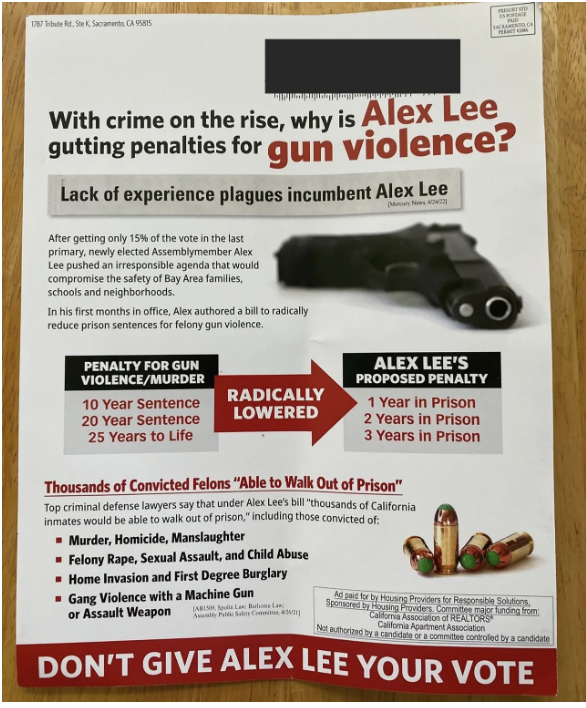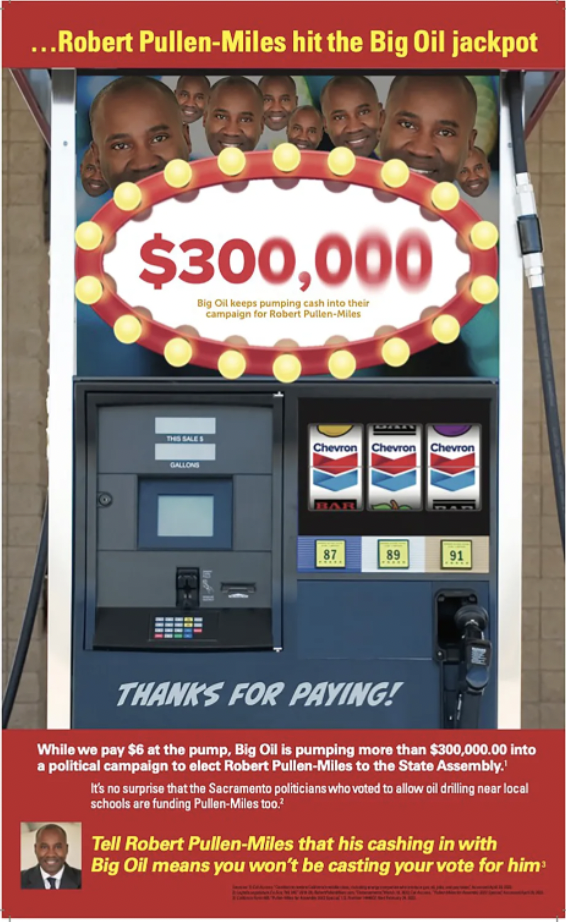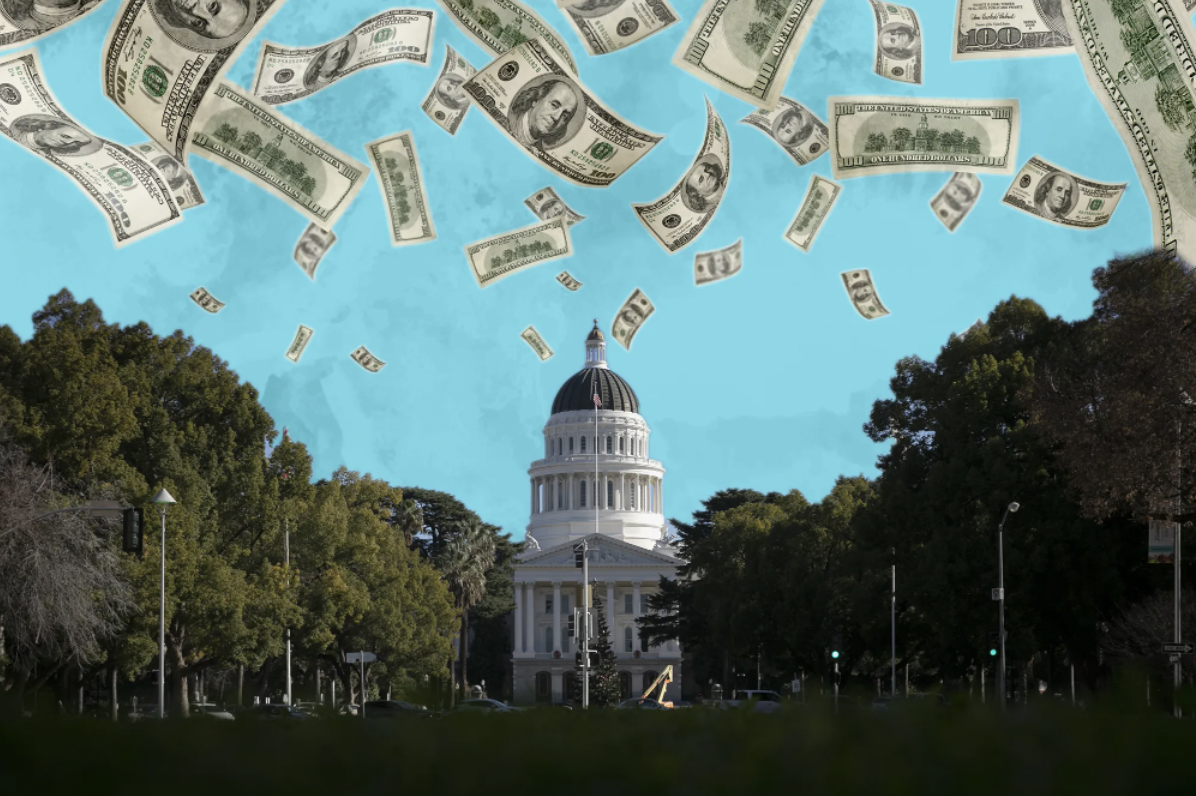If you haven’t noticed, your mail carrier certainly has: Election season has arrived in California and with it, the regular flood of political ads from unions, corporations and other special interest groups hoping to influence your vote.
Though contributions made directly to political candidates are capped by state law, no such limits apply to “independent expenditure” committees — so long as those outside influences are, in fact, independent and don’t coordinate with the campaigns they’re trying to help.
With early voting already underway and just two weeks to go before the June 7 primary, millions of dollars of help is now inundating California, showing up in races up and down the ballot. Perhaps you’ve driven past a curious bobble-headed billboard, had your mailbox stuffed with mailers sponsored by innocuous-sounding neighborhood groups or been puzzled by campaign ads that seem to be promoting the wrong candidate.

That’s all the handwork of what California election watchers refer to simply as “I.E.”
Though independent political spending is still dwarfed in California by old-fashioned direct contributions to candidates, it can play an outsized role in competitive elections, said Ann Ravel, who has served as the top campaign finance watchdog for both the state of California and the federal government. As an unsuccessful Democratic candidate for state Senate in one of 2020’s most fiercely competitive legislative races, she knows from first-hand experience.
“When you see it in person, it’s a lot different than when you see it as a regulator,” said Ravel, whose South Bay race against fellow Democrat Dave Cortese became a $6.2 million proxy battle between organized labor groups, housing interests and tech companies including Uber and Lyft.
“I remember thinking, ‘Oh God, now I have to go to all these meetings with all these people and suck up to them?’”
Unlike relatively small individual contributions, six-figure spending by a single interest group in a close race can be difficult for a candidate to ignore, she said. “You have to be able to compete…I think that’s the problem.”
Another common feature of independent expenditure committees, said Claremont McKenna College political science professor Jack Pitney, is that they most often play the role of bad cop, attacking candidates they want to knock off.
“It provides a certain degree of cover to the candidate who benefits,” he said. “They can’t be accused of going negative.”
Even for seasoned politicos and election reporters, the rivers of cash can be complicated to track — and sometimes even convoluted to make sense of. For the fascinated, outraged or perplexed voter, consider this your user’s guide.
Shades of blue
Accounting and financial oversight doesn’t always inflame political passions, but the race to become California’s next controller is shaping up to be among the most competitive statewide races. With five well-financed candidates — four of them Democrats — and no clear front-runner, it’s a remarkably open race. Just in terms of money raised by the campaigns, themselves, it’s the highest-dollar statewide race.
The conventional wisdom is that Lanhee Chen, the lone Republican, will snag one of the two spots for the November ballot. That leaves the four Democrats fighting for the second spot.
Enter JobsPAC, an IE committee sponsored by the California Chamber of Commerce.
“The race for a spot in the general election is a jump ball between the four major Democratic candidates — each start with limited name ID and no statewide bully pulpit for communications,” reads a strategic memo produced by the committee earlier this month.
Its Democrat of choice: state Sen. Steve Glazer of Walnut Creek. The committee’s goal, the memo continued, is to get out the pro-Glazer message “at a scale and frequency usually reserved for top of the ticket statewide and/or high profile congressional races.”
“Just to have an open seat for constitutional office is not too common,” said Marty Wilson, who oversees the Chamber’s IE activity. “We’ve had a longstanding relationship with Steve, so from our perspective for an open seat it was just natural that we would back him.”
Big business throwing its financial weight behind a preferred Democrat is not a new phenomenon in California. Given the lowly state of the state’s Republican Party, which hasn’t fielded a successful statewide candidate in California since 2006, the Chamber, along with much of the state’s business community, has long seen the pragmatism in backing moderate Democrats against more progressive alternatives in both statewide races and in legislative and congressional districts.
As a result, the most competitive races across the state often don’t pit Democrats versus Republicans, but candidates from different ideological factions within the state’s ruling party. It’s often in those races where independent expenditure committees funded by business, labor and other competing interests do electoral battle.
This year, those top targets for IE cash include an East Bay state Senate race, featuring Democrats Lily Mei and Aisha Wahab and a Sacramento state Senate standoff between Democrats Angelique Ashby and Dave Jones. In both races, those candidates are almost certain to grab the top two spots needed to make it to the November ballot. But money is flooding in early anyway as competing interests race to secure a healthy margin on Election Day, sully their opponents’ standing with voters and mount a financial show of force.
Other races attracting big spending this election season include competitive (though likewise thoroughly Democratic) Assembly races in San Diego, Hayward, San Mateo, Inglewood and Palmdale.
And while the biggest race for independent expenditures this year so far is the competitive contest for attorney general, in second place is the thoroughly non-competitive race for superintendent of public instruction. As of Friday, nearly $1.8 million had been spent to support incumbent Tony Thurmond. Virtually all of that came from a single committee funded by teachers and school worker unions.
Why spend so much to boost a relatively safe candidate in such a low-voltage race?
In a statement, Jeff Gozzo, a strategist with the committee, simply said: “Thurmond has shown real leadership for students, parents and educators.”
The ‘pick your opponent’ ploy
If you’ve been listening to the radio lately, you might have heard an ad that sounds as if it backs Democratic Attorney General Rob Bonta, but which dedicated a curious amount of airtime to his most conservative opponent, Republican Eric Early.
Rather than warn voters about Bonta’s better-funded challengers, Republican Nathan Hochman or unaffiliated Anne Marie Schubert, the ad noted that Early is a “true conservative,” a “huge Trump supporter,” “a big Second Amendment defender” and a “leader” in the recall effort last year to oust Gov. Gavin Newsom from office.
The ad was sponsored by the independent expenditure group Communities for Justice Supporting Rob Bonta for Attorney General 2022, which is primarily funded by uber-wealthy Bay Area liberals including Quinn Delaney and Patty Quillin, along with the state’s prison guard union, which endorsed Bonta.
Last week, another Bonta-backing committee reported spending another $250,000 to “oppose” Early.
What gives?
Boosting your own candidate while not-so-subtly raising the profile of your preferred opponent is a tried-and-true tactic in California.
In 2018, Newsom pulled the same maneuver in the lead up to the primary by blasting Republican John Cox. That was an effort to herd the fractured GOP base around Cox’s candidacy, ultimately to the detriment of Antonio Villaraigosa, a fellow Democrat and moderate alternative.
“Three-dimensional political chess,” is how San Francisco Chronicle reporter Joe Garofoli characterized the pro-Bonta ad. “This is how you get a Dem/Rep runoff,” tweeted Democratic political analyst Paul Mitchell. The California GOP, which endorsed Hochman, denounced the ad as a “misinformation campaign.”
Dan Newman, a consultant for Communities for Justice, said the messaging on Early is consistent with the committee’s own polling that he is most likely to finish second behind Bonta in June, beating out the much better financed Hochman and Schubert for a spot on the November ballot. Early, who ran for attorney general in 2018 and helped organize the 2021 Newsom recall effort, is “already relatively well known and well-loved in MAGA-land,” said Newman.
But the messaging also reflects the political calculation that Bonta would likely have an easier time against Trump-boosting an ultra-conservative, rather than a relatively moderate Republican or a party-less prosecutor famous for bringing the “Golden State Killer” to justice.
The Bonta campaign, itself, seems to have absorbed that lesson as well. In a recent press release, his campaign touted Republican opponent Hochman’s unclear stance on abortion. As messaging, it performs double-duty: celebrating Bonta’s progressive credentials on the issue for the Democratic Party’s base, while casting doubt on Hochman’s conservative bona fides with GOP voters.
But opponent shopping can be a risky game, said political scientist Pitney. In the 1966 governor’s race, Pat Brown “dumped a lot of opposition on George Christopher,” the moderate Republican mayor of San Francisco, in order to steer the GOP nomination to whom Brown’s camp believed to be the less electable alternative.
That “weaker” candidate, Pitney points out: “This washed up old actor named Ronald Reagan,” who went on to beat Brown by 15 percentage points.
What does the IE want?
When a politician’s campaign spends money, it’s easy to deduce what they’re after: They want to win their election.
Spending by independent expenditure committees — which sometimes cobble together contributions from many sources and may either support or oppose a candidate — can be a little more complicated.
Earlier this month a committee funded by the state’s landlord lobby and the California Association of Realtors, spent roughly $20,000 to support the candidacy of former Assemblymember Kansen Chu, a Democrat who is hoping to once again represent north San Jose. But the group is not solely interested in Chu. It spent about the same amount to boost both Fremont City Councilmember Teresa Keng and former San Jose City Councilmember Lan Diep, two other Democrats in the same race.

What do Keng, Chu and Diep have in common?
They aren’t Assemblymember Alex Lee, a self-described Democratic Socialist who supports rent control and believes the state should be providing housing directly to renters. So far, the committee has also spent more than $126,000 to defeat him.
That multi-candidate strategy might not be apparent to a South Bay resident who gets one of the committee’s mailers. To find out, a curious voter would have to look up the committee’s name — Housing Providers for Responsible Solutions — on the state’s online campaign finance portal.
While the inclusion of “housing providers” in that committee’s name offers a strong clue about its funding and policy preferences, not all IE groups are so instructively titled.
A notable example: San Diego Families Opposing Georgette Gómez, a significant spender in the race to fill the seat of former Assemblymember Lorena Gonzalez, who stepped down in January to lead the state’s largest labor organization and has endorsed Gómez. Her chief opponent is former City Councilmember David Alvarez. Some of the top funding for the “families” group comes from a list of similarly unhelpfully-named committees: Californians for Jobs and a Strong Economy and Keeping Californians Working.
Reported donations to those committees show that the ultimate source of the cash is a who’s who of some of the largest business interests in the state, including Uber, Amazon, Sempra Energy and Chevron.
And though a committee may carry on spending from one election to the next under the same name, that doesn’t mean its funders — or even its overall political purpose — stays the same. Another recent contributor to the San Diego Families committee is the Coalition for Public Safety Reform, Training and Transparency.
It was initially established by the Los Angeles Police Protective League, the union of LAPD officers, but the league was removed as a sponsor earlier this year. Since then, funding has come from organizations further south: the Deputy Sheriffs’ Association of San Diego County and Sycuan Band of Kumeyaay Nation near El Cajon.
Recycling existing committees for new political purposes and mixing and matching existing coalitions behind new names are both common practice, said Doug Morrow, a Democratic political researcher who tracks independent expenditures.
“The sponsors change, but the committees live on and the consultants get paid,” he said.
A double-edged sword
For a candidate, having a well-financed committee in your corner that can spend unlimited gobs of cash has its perks. But sometimes all that financial help comes at a political cost.
In the race to replace Autumn Burke, the former state Assemblymember who unexpectedly stepped down from her Inglewood seat earlier this year, candidates Robert Pullen-Miles and Tina McKinnor have both been beneficiaries and targets of an inordinate amount of independent expenditures.
The biggest spenders rushing in to assist Pullen-Miles, a former Burke staffer who has her endorsement: oil giants Chevron and Valero through a longstanding committee called Coalition to Restore California’s Middle Class. In an overwhelmingly Democratic district that extends to the beach, that isn’t likely to be a popular association. Pullen-Miles’ opponents are using that to their advantage, characterizing him as the candidate of “big oil.”

McKinnor, a former Burke staffer who left that post on bad terms, and who was also a high-ranking organizer in the state Democratic Party, has the backing of progressive groups and much of organized labor. But she, too, has some industry spenders in her camp that have proven to be a political liability. The biggest spending pro-McKinnor committee, the Alliance for California’s Tomorrow, is funded in part by the tobacco company, Philip Morris. With that connection in hand, the Pullen-Miles campaign threw together a website drawing attention to his opponent’s “dirty dollars.”
As an illustration of just how convoluted these financial interventions can be: When Burke, Pullen-Miles’ backer, was first elected to the Legislature in 2014, the Alliance for California’s Tomorrow spent more than $60,000 to help her.
A similar kind of guilt by financial association has come to dominate the race to fill the state Senate seat in Sacramento to be vacated by termed-out Democrat Richard Pan. There, former Insurance Commissioner Jones has been the subject of a gauntlet of negative ads funded by Future PAC. Most notable among them — a billboard emblazoned with a Jones bobblehead.
Future PAC, which has spent nearly $500,000 so far to hammer Jones, serves as a clearinghouse for a wide variety of industry groups and unions, including hospital associations, pharmaceutical companies, agricultural interests and the umbrella organization for the state’s police officer unions.
But Jones and his supporters have fastened onto one contributor in particular: Californians for Jobs and a Strong Economy, another business-backed IE committee, supported in part by oil and energy companies. “Big Oil wants Angelique Ashby,” says a mailer from California Alliance, an IE funded by California Environmental Voters, Consumer Attorneys of California and Opportunity PAC.
Ashby, a Sacramento City Councilmember, responded in a tweet Monday that she has kept a pledge not to take fossil fuel money in her campaign.
“The IEs have the money and so whoever the IEs are for or against, that’s used to define the candidate,” said Steve Maviglio, a Democratic political consultant who supports Ashby and has volunteered with her campaign. “They’re not helping.”
